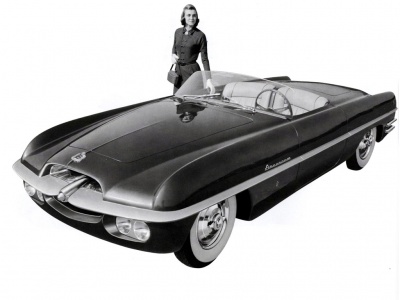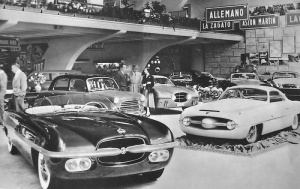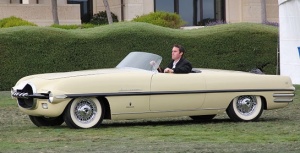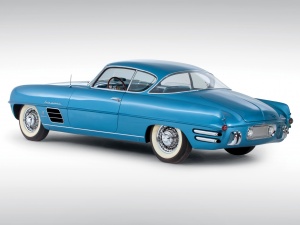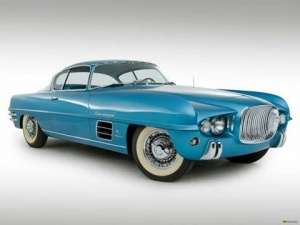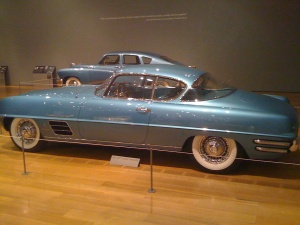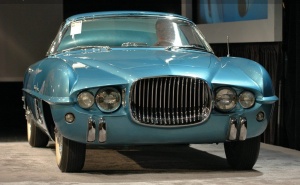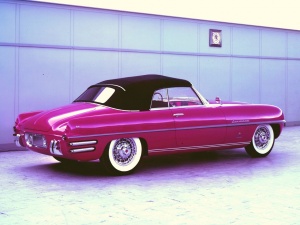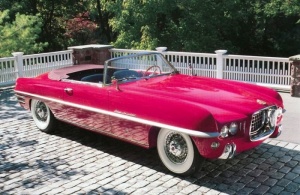Difference between revisions of "1953-54 Dodge Firearrow (Concept Car)"
m (BK moved page Firearrow to Dodge Firearrow) |
m (BK moved page Dodge Firearrow to 1953-54 Dodge Firearrow (Concept Car)) |
Revision as of 23:13, 12 April 2020
.
Fire arrows are an early form of gunpowder solid fuel rocket which were attached to a shaft of the arrow to provide a propulsive force. The Chinese are credited with both the invention of the fire arrow and also the first use of fire arrows in a military warfare.
However since this is the MoparWiki, the name Fire Arrow was applied to four (actually 3.5 as the first was a Pushmobile) Dodges in Virgil Exner had commissioned as Dream Cars in 1953 and 1954. There were designed to be Chrysler's version of the Chevrolet Corvette, and Ford Thunderbird. The Firearrows followed a logical progression from dream car to producible vehicle.
Contents
Background of The Exner Era Dream Cars
Quick History of Exner
In 1932, A 23-year-old Virgil Exner was hired by GM's Art and Color Studio. Boss, Harley Earl immediately recognized Exner's design talent. Two years later Enxer was put in charge of the entire Pontiac Studio, a job he kept until 1939 when Raymond Lowry hired him to work on his studio's design contract with Studebaker. Exner worked with Lowry and Studebaker all through WWII, and when the highly advanced 47 Studebaker's were shown to the public in 1946, they were touted as "The First By Far With A Post War Car. It would be the 1949 Model year when the "Big Three" would catch up.
A dispute between Lowry and Exner over credit for the design of the 52 Studebaker caused Exner's firing. Studebaker wasnt impressed with the Lowry proposal for the 52s, and Exner showed them a design he'd been working on at home on his own time. Studebaker liked it and Lowry wanted credit for his employee's work. He was fired when he refused, but Studebaker picked Exner up for their in-house design team. There was little love between Lowry and Exner for the rest of each of their lives.
In 1949, Chrysler President K. T. Keller hired Exner away from Studebaker for the purpose of designing cars that would improve Chrysler's stodgy image. The Chrysler Corporation was well known for its engineering firsts, but not its styling. The Chrysler Corporation's "Small on the Outside - Big on the Inside" designs looked ancient when compared to the 49 Ford and GM offerings. Keller wanted the cars designed to where a man could drive with his hat on. This made the cars appear too tall.
At first Exner worked secretly on Advance Designs, but was soon promoted to head the studio. The model year designs were already locked in through 1954, so Exner began work on the 1955 model, the first year of the "Forward Look" designs.
Keller and Exner agreed that they should step up Chrysler's showing of Dream Cars to compete with Harley Earl's million dollar dream cars displayed in the Motorama shows. They felt this would create excitement with the public on updated designs that would hit the showrooms in the future. However, they would have to do it on a budget no where near the size GM had given Earl.
Exner and Ghia
While working on his first of the Chrysler Dream Cars, the K-310, Exner and his design team were at an impasse. On a previous trip to Italy, K. T Keller commissioned both Pininfarina and Ghia to each build a car of his loose design specs, but allowed them design creativity. The purpose was not to test their design skills, but to test them for quality, fit and finish.
Knowing that the Exner team was having trouble with K-310, Keller invited the team to view the cars that had just arrived from Italy. Pininfarina had closely followed the specs, while Ghia took great liberties with their allowed creativity. Ghia's car was very impressive. The Ghia submission was also far better in quality, fit an finish than the submission from Pininfarina. It was to became the Plymouth XX-500 show car. In addition to Ghia's craftsmanship, their design abilities were a pleasant surprise.
This began the long relationship between Chrysler and Ghia, and more importantly - collaboration between their designers.
Fire Arrow I
The first one-which we ought only to count as one-half-was a "buck" on a Dodge chassis. It didn't run and was really only one step up from a full-size clay model. Establishing a proportion Exner strove for, this 1953 Firearrow I was more than twice as wide as its body height at the cowl. "The body itself is flat and broad with only a slight crown, or slope, in its top and side surfaces," said a contemporary description. "Stylists have a word for this . . . they call it 'tautness': the metal between any two points seems stretched to fill the space smoothly, with no wasted contour, rather than appearing full-blown or overly curvaceous." It was the diametric opposite of typical mid-Fifties design.
Certain themes showed cross-pollination -- everyone in Detroit knew each other and ideas got around. For example, the concept of a massive bumper/grille, flowing around at the sides, may have originated at the Kaiser-Frazer studios in the late 1940s, while the Firearrow's chrome exterior tailpipes were seen in almost the same place on Frank Spring's Hudson Italia, the first of which was built in mid-1953. On the latter they merely housed taillights; on the Firearrow they were fully functional.
The full-perimeter bumper was painted metallic gray rather than chromed; the car itself was red metallic, with a yellow-buff leather interior piped in maroon. This model also had quad headlamps, possibly their first appearance on a show car. (They first appeared in production on the 1957 Nash and Cadillac Eldorado Brougham.)
Fire Arrow II
Next in line was the 1954 Firearrow II, another roadster, but modified in detail. Mounted on a stock 119-inch Dodge Royal wheelbase, it was powered by a 250-horsepower Royal V-8 with Gyro-Torque Drive (Chrysler's famed M-6 Fluid Drive with torque converter). While its basic shape was unchanged from the Firearrow I, the quad headlights had disappeared, replaced by single lamps faired into pods at the front end, breaking up the full-perimeter bumper. The grille and taillights were restyled and there were two rear deck hatches: one to hold luggage, another for the spare tire and fuel filler. Each was counter-balanced and spring-loaded to pop open when levers were pulled inside the driver's door. Other features attested to the Firearrow II's pure experimental nature: There were no door handles, no rear-view mirrors, no side windows, no top. Doors were opened by pressing a flat metal release bar at the top inner molding or, from the inside, by pulling a knob that extended into the painted armrest support.
The Firearrow II was painted pale yellow with a black central bar through the grille (similar to the 1953 Plymouth grille bar) and black body-side molding; black leather adorned the interior. The doors were similarly upholstered, and because of their deep curves they allowed generous armrests, which gave "a pronounced recessed effect to the cockpit sides," according to Chrysler. The dash contained full instrumentation, including tachometer, plus toggle lever controls and an aluminum-spoked steering wheel with a wooden rim.
One novel feature of the dummy roadster was carried over to Firearrow II: a huge, one-piece, glass windshield. But whereas the mock-up's windshield had a thin frame and was carried in a grooved metal base affixed to the cowl, Firearrow II's was sunk into a deep "slot." The glass you saw was only the tip of this glacial mass: There were 14 inches showing above the cowl and 24 inches sunk into the slot! Unlike the mock-up, the Mark II's glass was tempered, but owner Joe Bortz is wary of taking chances with it: "It's crystal, and very fragile. We've made a foam slipcover for it and a metal cage to protect it when traveling. The restoration man wanted to make a plexiglas copy but I was afraid he'd break the original in the process -- and once gone, it would be gone for good."
Fire Arrow III
The 1954 Dodge Firearrow III featured a chrome grille mounted into a rectangular opening with vertical slats that served as air intakes. There were four headlights with two hi-lo sealed beam bulbs coupled with smaller high-intensity bulbs to the outside. Below the main lights were a pair of chrome bumperettes with two parking-turn signal lights to the outer edges. The artistic styling reached virtually every aspect of the car, including the hand-crafted chrome exhaust pipes, the rearward sloping lid for the trunk, tail lights in the trailing edges of the rear fins, and flash-mounted back-up lights in the rear license plate holder. The Firearrow III was used by Chrysler at the opening of its new Chelsea Proving grounds in 1954.
After engine modifications, Betty Skelton took the Mark III around Chrysler's new Chelsea, Michigan, banked test track at 143.44 mph, setting a new ladies' closed-course world speed record.
Fire Arrow IV
Last of the Firearrows was a late 1954 convertible, another practical car with roll-up windows, trunk, and conventional door handles; it also had a functional soft top. "I think we could have built that," Maury Baldwin, an Exner colleague who himself designed the 1955 Plymouth. "But management at that point was very stodgy. A lot of people attributed it to the old Airflow disaster. They were afraid to make any new inroads." Flashiest of the series, Firearrow IV had a bold quilted black and white diamond-pattern leather interior; the front seats reclined, while the rears could be lifted out, revealing a mahogany luggage platform with chrome skid strips. Painted bright red, it was probably the most significant of the series, because it influenced a limited-production car, the 1956-1958 Dual-Ghia (of which 177 were reportedly built). There are no interchangeable panels between the two.
Designer
Virgil Exner was given credit for this design group
Chassis
Stock 119-inch Dodge Royal wheelbase
Body
Interior
Drivetrain
- Powered by a 250-horsepower Royal V-8
- Gyro-Torque Drive (Chrysler's famed M-6 Fluid Drive with torque converter)
Car Shows
Movies Appeared in
Magazine Articles
Reference
- How Stuff Works http://auto.howstuffworks.com/1953-1954-dodge-firearrow.htm
Internet Links
- MoparStyle.com http://www.moparstyle.com/forums/
